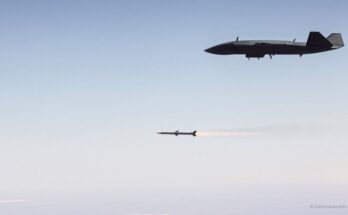by Dan Darling, International Military Markets Analyst, Forecast International.
The Hellenic Defense Ministry announced on February 7 that Greece intends to move forward on an upgrade to its large inventory of F-16C/D combat aircraft and begin exploring a future purchase of the new-generation F-35 from the U.S.
The first project represents a much-needed focus on deteriorating Greek military capabilities in the air-sea domain, while the second remains an over-the-horizon dream nowhere remotely near Athens’ current fiscal reality.
Since the opening phase in 2009 of what has become Greece’s ongoing fiscal crisis, the Hellenic Armed Forces have witnessed a steady deterioration to their once-proud military.
Prioritized under annual government budgets due to the country’s proximity to traditional and strategic rival Turkey, the Hellenic Armed Forces for decades represented one of the best equipped and financed militaries among European NATO members. Even today, despite repeated – oftentimes severe – funding reductions, Greece remains one of just a handful in NATO to devote 2 percent or more of its annual GDP toward defense.
Nonetheless, Greek defense budgetary allocations underwent a net contraction of 161 percent between 2009 and 2015.
The steady evaporation of annual top-up funding sharply curtailed everything from training and military exercises to maintenance, upgrades and procurement of equipment. Modernization projects outlined as far back as 2006 remained frozen in place or were scrapped altogether as Greece confronted a sovereign debt crisis that hindered Athens’ financial flexibility, forcing it to seek relief from the so-called troika consisting of the European Commission, the European Central Bank, and the International Monetary Fund (IMF). Added to this struggle was a brutal recessionary streak endured from 2009 through 2013, during which the Greek economy shrank by a quarter, resulting in a 25 percent reduction in national wealth.
Despite the Hellenic Air Force’s many requirements – ranging from new lead-in jet trainers to search-and-rescue helicopters and new batches of modern combat aircraft to replace aging fleets of McDonnell Douglas F-4E Phantoms and retired Northrop Grumman A-7 Corsairs – the modernization of the Hellenic Air Force remained, effectively, at a standstill. By mid-2011 it was estimated that only 60 percent of the Air Force’s fleet of 300 jet fighters were fly-worthy.
Against the negative backdrop in Greece stood the continuing growth of Turkey’s economy and, in parallel, its defense budget and military modernization efforts. Years of shrinking Greek defense budgets served to steadily erode what qualitative military-technological edge the Hellenic Armed Forces had held over their Turkish counterparts.
Of particular concern to the Hellenic Air Force is Turkey’s planned purchase of at least 100 “fifth-generation” F-35 Lightning II jet fighters. An initial lot of 10 F-35s was ordered by Turkey in 2014, with first deliveries set for 2019. Once these aircraft are brought into Turkish service, Greece will suffer from both a quantitative and qualitative deficit in terms of combat airpower.
While recognizing that the Hellenic Air Force will never be able to match its Turkish counterpart plane for plane, Greece has long remained intent on maintaining par on a qualitative level – thus the interest in both an F-16 upgrade program and a long-term procurement of the F-35 by the Hellenic Ministry of Defense following years of equipment inactivity in the airpower domain.
In an effort to further secure its airspace, Greece also intends to secure a maintenance deal for its 12 Russian-made S-300PMU Favorit surface-to-air missile systems that would include an upgrade to their radar systems. Greece is the only NATO member to field the S-300. Greece has been negotiating with Russia regarding an S-300 maintenance (and missile acquisition) agreement since April 2015.
But for now the immediate focus appears to be on the F-16 fleet and a prospective upgrade to the F-16V Viper variant that would greatly modernize the aircraft while extending its serviceability out another two decades.
The Hellenic Air Force F-16 fleet was procured in successive stages from the U.S. beginning in 1988 under the Peace Xenia program actioned through the Pentagon’s government-to-government Foreign Military Sales (FMS) channel.
The Viper represents the most modern F-16 configuration and includes new APG-83 active electronically scanned array (AESA) radar, an upgraded mission computer and architecture, and an improved cockpit. The first test flight on an F-16V model occurred in October 2015 and was conducted successfully.
Greek Defense Minister Panos Kammenos signed off on a letter of request (LOR) to the U.S. on February 7 formally launching the FMS process for the F-16V upgrade.
Because the cost of this upgrade is estimated at roughly $1.7-$2 billion – funds the Greek defense budget, at $4.6 billion in 2016, can ill afford to address in a single outlay – payments will be spread over multiple years in order to ease the financial burden.
As for any potential F-35 procurement, this appears to be a long-term goal at best.
Considering Greece’s current debt-to-GDP ratio of 177 percent, infighting among creditors in Athens over whether a 3.5 percent budget surplus requirement for 2018 is feasible, and unease in the eurozone over continuing to provide bailout loans to Greece, there is little fiscal daylight for Athens to move forward on such a splashy military acquisition (particularly for American hardware over a European option). The IMF has warned that the demands placed on Athens by the European Union under the Greek financial relief program are unrealistic and that by 2022 the country’s debt load will become “explosive.”
As it stands, Greece only has enough cash on hand to last into July before requiring additional shares of the EUR86 billion ($92 billion) in bailout aid negotiated between the EU and the far-left Syriza-led Greek government in 2015. With the possibility of default – however slight at the moment – staring Athens in the face, the idea of procuring the expensive F-35 in any volume is a non-starter.
Greece will have to witness greater cohesion in its political domain, the steadying and subsequent expansion of its economy, and some daylight beyond the sovereign debt cloud currently hanging over it before even beginning to contemplate the purchase of a fighter with a current unit base price of $95 million. Even if unit prices continue to fall as series production ramps up, for now and the foreseeable future Greece is in a poor position to contemplate anything beyond a sale by the U.S. or another ally of secondhand F-35s – and that would be decades away.
Please feel free to use this content with Forecast International and analyst attributions, along with a link to the article. Contact Ray Peterson at +1 (203) 426-0800 or via email at ray.peterson@forecast1.com for additional analysis.
The Forecast International International Military Markets series examines the military capabilities, equipment requirements, and force structures inventories of 140 countries, with corresponding coverage of the political and economic trends shaping the defense market outlook for individual countries and regions.
For 50 years, Forecast International intelligence reports have been the aerospace and defense industry standard for accurate research, analysis, and projections. Our experienced analysts compile, evaluate, and present accurate data for decision makers. FI's market research reports offer concise analysis of individual programs and identify market opportunities. Each report includes a program overview, detailed statistics, recent developments and a competitive analysis, culminating in production forecasts spanning 10 or 15 years. Let our market intelligence reports be a key part of reducing uncertainties and mastering your specific market and its growth potential. Find out more at www.forecastinternational.com


